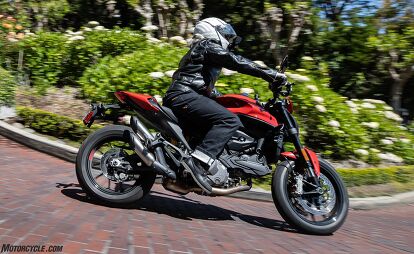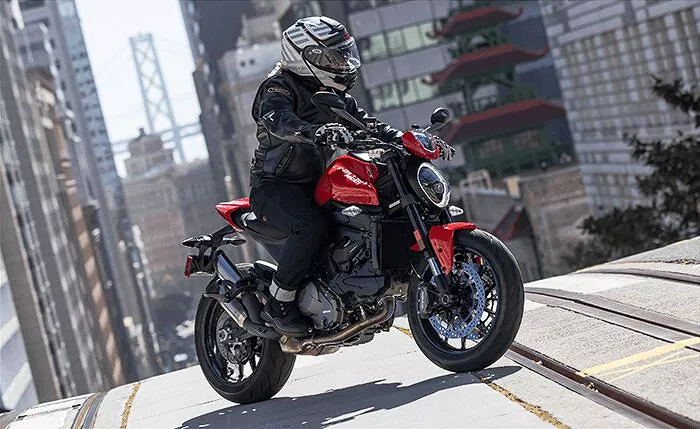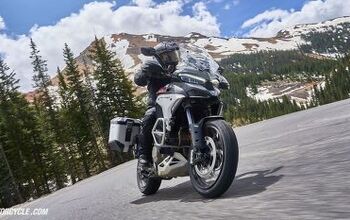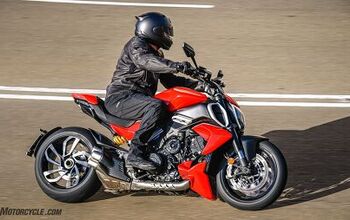2021 Ducati Monster Review – First Ride
The bike that ate Bologna, Season 27 Episode 1
Ok, I’m old, so what? When I was young, the first Monster M900 (1994) spoke to me. A basic, naked, standard Ducati that was perfect for rumbling round the urban maze back when we all had a downtown office to go to… a svelte Italian Sportster that bounced its mating call off the concrete canyons all the way to 9000 rpm. It really was a radical departure since, before then, Ducati had only built fully-faired assume-the-position sportbikes, and not many of them. They were great on the Futa Pass and Angeles Crest but not so much anywhere else. Later, when we grew power-hungry in the ’oughts, there came the 996-powered S4R, then the Monster 1200s…
2021 Ducati Monster
| Engine | 18.0/20 |
| Suspension/Handling | 12.5/15 |
| Transmission/Clutch | 9.0/10 |
| Brakes | 9.0/10 |
| Instruments/Controls | 4.5/5 |
| Ergonomics/Comfort | 9.0/10 |
| Appearance/Quality | 8.5/10 |
| Desirability | 8.5/10 |
| Value | 7.5/10 |
| Overall Score | 86.5/100 |
I’m pretty sure I’m no longer the target audience, but 27 years down the road, I can’t help thinking Ducati’s keeping an eye on me and every inch of girth I gain, with every new Monster they design: The ergonomics and user interface of this latest one are the kindest, least monstrous ever. They’ve stuffed more of some exclusive foam into the seat, narrowed the bike between the knees. They’ve pulled the handlebar 2.6 inches rearward, and moved the footpegs 0.4 in. lower and 1.4 in. rearward compared to the previous Monster 821. It always was, but now, the Monster’s an even easier bike to just hop on and go, and feel immediately comfortable.
You Look Different?
Mostly it’s what they’ve taken away from the new Monster that makes it nicer to ride than ever: 40 pounds. Love it or hate it, the new aluminum monocoque “frame” and GFRP (Glass Fiber Reinforced Polymer) subframe lop off around 15 pounds. The new swingarm gets rid of another 3.5 pounds, the wheels are said to be lighter by nearly 4 pounds total, and the new Testastretta 11° V-twin takes off another 5 lbs. Suddenly you’re at 366 lbs dry, says Ducati, and 414 ready to ride. That’s 8 pounds more than the Yamaha MT-07 Troy just rode, and 3 pounds less than the new MT-09. It’s also right in there with KTM Duke 890 and Triumph Street Triple – all motorcycles defined by their lightweight athleticism.
Urban Grind
For getting around the city, the Monster is right there with the best of them. Getting rid of the steel frame freed up a lot of room in the headstock area, which gives the new bike 7 degrees more steering sweep in both directions. That makes it possible to turn around in the tightest alleys, and slalom quickly through the dumpsters. (Show some respect; people are trying to sleep in many of them in San Francisco, where we went to ride the new bike. I kid, people are only trying to sleep in a few dumpsters. Most of San Francisco is a beautiful place.)
Furthermore, the new (lack of) frame makes the Monster waif-like between the knees, which makes it easy to touch the ground and reinforces its nimbleness. In fact, Ducati really wants it to be approachable for less experienced and/or shorter riders. The standard seat is 32.3 inches, but the low option is 31.5 in. – and there’s a $300 suspension lowering kit available to take it down another inch.
There’s a new hydraulically actuated clutch lever at your left hand, which is way easier and smoother to engage than Monsters of yore, and the clutch itself is a slip/assist unit. Internal changes to the 6-speed gearbox make for light, precise shifts – until you remember you’ve got a standard up/down quickshifter and barely need to think about shifting. Stuck in traffic with the group (you’d never get stuck if you were by yourself on the Monster), it’s easy to snick into neutral even when you’re stopped.
Since this is a semi entry-level Ducati and we’re trying to keep the price down, we’re not getting fully adjustable electronic suspension, but the inverted 43mm fork and single cantilevered shock out back, with dual-rate spring, work nicely together: 5.1 inches travel in front and 5.5 out back smooth out 88% of San Francisco’s larger lumps, trolley tracks, and chunks of construction debris. A large degree of credit goes to that cush new seat, too. The only ergonomic complaint you might lodge, if you have big feet and are whatever the opposite of pigeon-toed is, is that your heels might not like the passenger peg carriers, especially the right one that’s also the exhaust hanger.
Big Honkin’ Angry Goose
To move into the Euro 5 era, Ducati replaced the previous 821 cc Testastretta 11° with the 937 cc version. In Monster trim, Ducati claims 111 hp at 9,250 rpm with torque peaking at 69 lb-ft at just 6,500 rpm. That’s 2 hp more than the 821 had. But only a slightly disappointing 1.5 more lb-ft of torque, given the 116 more cc and compression ratio bump to 13.3:1 of the new engine. It is cool that the torque peak – 6500 rpm – arrives 1200 rpm sooner than before.
Anyway, there’s no shortage of power. There’s plenty of torque to get rolling right off idle, but whatever’s going on in the new airbox, at 5000 rpm or so and big throttle openings, there’s a big bump in volume and power as the Monster gets down to whatever business you point it at, including hoisting its front wheel in the air. All the latest electronic aids have trickled directly down from the Panigale, including wheelie control, and setting 1 in second gear is a good place to acquire that skill without fear of over-rotating, if you’re up for it, so to speak.
For me, it all feels quite a bit torquier than the numbers indicate; the Monster’s newfound midrange reminds me a lot of the Indian FTR1200’s immediate punch. It’s not as powerful as the FTR, but the fact that the Monster’s 100 pounds lighter than the FTR makes it just as eager. You’ve got the usual ride modes, but even in the most aggressive – Sport – power delivery is perfectly acceptable and smooth, and riding up Lombard Street (you can only ride down it without a police escort) is a doddle in first gear with a little clutch here and there.
Part of the Ducati L-twin charm was always a slight lumpy-cam idle at small throttle openings, and that’s still there. But the power comes instantly and smoothly online when you twist the throttle. It’s a proactive engine that prefers to be accelerating, not hanging around. I’m told “Urban” transforms it into a pussycat around town, but I didn’t feel like a pussycat that day. Sorry.
Exurban
Busting out of the city south on I-280, the Monstrosity is still pulling strong at 111 mph on the new 4.3-inch TFT display when other, slower traffic interrupts the road test. But with no fairing, 83 mph and 5000 rpm are where you’d prefer to be most of the time for daily use. Above 100, you might contemplate whether a steering damper might not be a good investment for the steep, short Monster. Our wheelie-happy friends report that you need to be sure to set the front wheel back down straight.
Though it’s supposed to be a city bike, the Monster feels equally at home riding the squiggliest lines on the map. Short of wheelbase and trail and with a wide but not too-wide handlebar, perfectly decent suspension suspending full-size Diablo Rosso III tires, and three strong, predictable disc brakes, a good rider on a Monster could keep up with any sanely-ridden motorcycle. And probably have more fun and less stress than on Ducati’s heavier, longer, 208-horsepower Streetfighter V4.
The standard up/down quickshifter is nice to have all the time, but particularly sweet downshifting into tight hairpins and making use of the slipper clutch. The cut time on the shifter is tied into the new IMU: The computer gives less lag time when the bike is straight up and down and accelerating. More lag time when it’s leaning over and downshifting means less chance of upsetting the chassis as you dive into the corner.
Modern electronics
On temperate days, there’s no reason why the Monster couldn’t be a great long-distance commuter or traveller except for one glaring one: There’s no cruise control button and no optional one in the catalog either.
Which is doubly inexcusable, since we just went fully Euro 5 ride-by-wire and even added an IMU (inertial measurement unit) to bring all the latest lean-sensitive ABS and traction control systems on board. Fans of backin’ her in rejoice: In ABS setting 1 (of 3), rear ABS is deactivated. You’ve got eight levels of traction control plus Off, four levels of wheelie control plus Off, and three levels of engine power you can set independently of the three standard ride modes. You’ve even got launch control. Be sure to check that the intersection is safe before proceeding.
The TFT is nicely colorful, packed with information that’s probably easy to find after you’ve ridden the bike a while, and switches from day to night automatically. Now we’ve got full LED lighting including turn signals (well, they’re still awaiting US certification), and a daytime running light that lends a kind of beatific aspect to the Monster.
Anyway…
If you’re one of those people who’s bent out of shape because the pretty trellis frame is gone, you might as well just get over it. As Ducati points out, the original Monster recipe was the previous-generation engine in the superbike frame. Which is exactly the recipe for this one. Also, they’ve sold over 350,000 Monsters to date, so if you don’t like this one there are literally tons of pre-owned Monsters of every stripe looking for a good home.
Bottom Line
How much would you expect to pay? $11,895 in Monster Red seems about right, and $200 more for Aviator Gray or Dark Stealth. Monster + adds a fly screen that’s more a fig leaf, and a passenger seat cover, for $200 more – that’s $12,095 in red. Not bad for a Ducati. Not great for the class: Riding home, I lane-splat for a while with a guy on a brand-new Yamaha MT-09 SP, which comes with premium suspension and cruise control, for $11k.
But then, the dark side of Japan may not be your bag if you’re lusting after a Ducati. It’s true, the bolides from Bologna, the Italian stallions, whatever you call them – do have a certain swagger, and do get you membership in the Ducati club. Wikipedia informs us that on September 21, 2008, “a gathering of Ducati Monsters in Hamme-Moerzeke, Belgium, broke the Guinness Record for the ’largest parade of motorcycles of the same brand and type.’ 405 Ducati Monsters were tallied.”
Wait, has no one in Belgium been to Sturgis or Daytona?
That’s beside the point. The point is, welcome to the new Monster, same as the old Monster. But more sophisticated, comfortable, lighter, lither, and more “fun to ride” than ever.
2021 Ducati Monster
+ Highs
- Light weight, skinny waist, great ergos
- Monsterish midrange power
- Full IMU-based electronics
– Sighs
- No cruise control
- Grip heaters are controlled via the computer
- No cruise control
In Gear

Helmet: Shoei Neotec 2 Splicer $799
- Jacket: Vanson AZ2$539
- Gloves: Dainese 4-stroke $249
- Jeans: Sa1nt Unbreakable $299
Boots: Sidi Arcadia Tex $179
2021 Ducati Monster Specifications | |
|---|---|
| Engine Type | Testatretta 11°, V2 – 90°, 4 valves per cylinder, desmodromic valvetrain, liquid cooled |
| Displacement | 937 cc (57 cu in) |
| Bore x Stroke | 94 mm x 67.5 mm |
| Compression Ratio | 13.3:1 |
| Power | 111 hp (82 kW) @ 9,250 rpm (claimed) |
| Torque | 9.5 kgm (93 Nm, 69 lb ft) @ 6,500 rpm (claimed) |
| Fuel Injection | Electronic fuel injection system, Ø 53 mm throttle bodies with Ride-by-Wire system |
| Exhaust | Pre-muffler and twin muffler, catalytic converter and 2 lambda probes |
| Transmission | 6 speed |
| Primary Drive | Straight cut gears, ratio 1.85:1 |
| Gear Ratios | 1=37/15, 2=30/17, 3=28/20, 4=26/22, 5=24/23, 6=23/24 |
| Final Drive | Chain, front sprocket z15, rear sprocket z43 |
| Clutch | Slipper and self-servo multiplate wet clutch with hydraulic control |
| Frame | Aluminum alloy front frame |
| Front Suspension | Ø 43 mm usd fork, 5.1 inches of travel |
| Rear Suspension | Progressive linkage, preload adjustable monoshock, aluminum double-sided swingarm, 5.5 inches of travel |
| Front Wheel | Light alloy cast, 3.5″ x 17″ |
| Rear Wheel | Light alloy cast, 5.5″ x 17″ |
| Front Tire | Pirelli Diablo Rosso III 120/70 ZR17 |
| Rear Tire | Pirelli Diablo Rosso III 180/55 ZR17 |
| Front Brake | 2 x Ø 320 mm semi-floating discs, radially mounted Brembo M4.32 monobloc 4-piston callipers, radial master cylinder, Cornering ABS |
| Rear Brake | Ø 245 mm disc, Brembo 2-piston floating calliper, Cornering ABS |
| Instrumentation | 4.3″ TFT colour display |
| Dry Weight | 166 kg (366 lb), claimed |
| Curb Weight | 188 kg (414 lb), claimed |
| Seat Height | 820 mm (32.3 in) 800 mm (31.5 in) (accessory low seat) 775 mm (30.5 in) (accessory low seat + low suspension kit) |
| Wheelbase | 1,474 mm (58.0 in) |
| Rake | 24° |
| Trail | 93 mm (3.7 in) |
| Fuel Tank Capacity | 14 l (3.7 US gal) |
| Number Of Seats | 2 |
| Safety Equipment | Riding Modes, Power Modes, Cornering ABS, Ducati Traction Control, Ducati Wheelie Control, Daytime Running Light |
| Standard Equipment | Ducati Quick Shift, Ducati Power Launch, 4.3″ TFT colour display, Full LED headlight and lighting system, Dynamic turn indicators, USB power socket |
| Ready For | Ducati Multimedia System, Heated grips |
| Warranty | 24 months, unlimited mileage |
| Maintenance Service Intervals | 15,000 km (9,000 miles) / 12 months |
| Desmoservice | 30,000 km (18,000 miles) |
We are committed to finding, researching, and recommending the best products. We earn commissions from purchases you make using the retail links in our product reviews. Learn more about how this works.
Become a Motorcycle.com insider. Get the latest motorcycle news first by subscribing to our newsletter here.
More by John Burns





































































Comments
Join the conversation
I have to be honest, I don't mind Ducati steppin' of the trellis frame. I will be eager to test it and publish it on my (Dutch) website: https://motorstof.nl
I’ll bet that slab-sided aluminum frame does nothing to ease valve adjustment access. Just say’in...